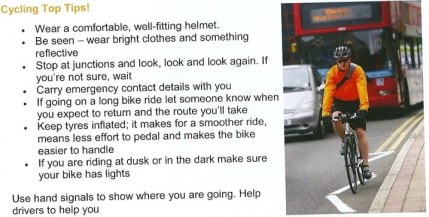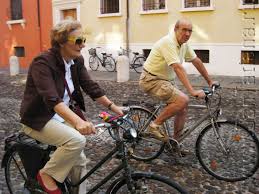From Halfords cycle2work leaflet
Halfords, as well as being a large car parts and servicing business, is a major cycle retail business and operates a “Cycle to Work” government approved initiative to enable employees to use a bike and accessories to cycle to work. We think the extract from their “cycle2work” leaflet sends out the wrong message about cycling. Here’s why:
· Wear a comfortable, well-fitting helmet.Cycling, even in contemporary conditions is low risk – comparable to walking, and even more so car journeys over longer distances, for which helmets are never recommended. Cycle helmets are – and can only be – designed to withstand low impact forces, equivalent to falling of a bike from a stationary riding position. They are not designed for impacts with motor vehicles, especially not heavy vehicles or those moving at speed. This means that they can’t be relied on to give any protection in life-threatening impacts. The injuries they can reduce are generally minor and easily survivable. Factor in the adaptive behaviour of other road users to helmeted cyclists – and the adaptive behaviour of helmeted cyclists themselves – and you see why there is no evidence of any safety benefit over a population over time for their effect.
· Be seen – wear bright clothes and something reflective. Again, an absence of evidence, and a victim-blaming slant which takes attention away from the responsibilities of motorists. “Being seen” means pressuring drivers to look where they are going: “Never drive in such a way that you cannot stop within visible distance”. Are Halfords well known for effective attempts at promoting this? And is the cyclist in the photo – not in the kind of position recommended by “Bikeability” National Standards cycle training – positioning himself so that he is more likely to “be seen”?
· “Stop at junctions and look, look and look again. If you’re not sure, wait”. Hardly a description of a confident and assertive cyclist, is it? Where do you look and what are you waiting for? None of the “Top Tips” includes developing cycling confidence through Bikeability training. Of course, on the other side of the leaflet they do refer to cycle training delivered by the Institute of Advanced Motorists. Will this be empowering, and provide knowledge of cyclists’ rights as well as responsibilities?
· “Carry emergency contact details with you”. You’re probably going to die! At this point we have to draw breath and remind people of the paradox of road safety. Cycling is not inherently hazardous. Even in current conditions casualty rates are low. You are probably NOT going to die. This DOES NOT mean that what many motorists (the source of road danger) are up to is in any way at all acceptable. It shouldn’t be difficult to see that this is an apparent contradiction (or paradox) and not an actual one. The point is to understand the level of risk and to deal with danger at source – for all road users.
· “If going on a long bike ride let someone know when you expect to return and the route you’ll take.” Infantilising and “dangerising” cycling. This is exactly the right way to put people off cycling. It feeds in to the “fear of cycling”.
· “Keep tyres inflated: it makes for a smoother ride, means less effort to pedal and makes the bike easier to handle.” Something which actually makes sense. A big problem in the UK is that since the loss of cycling as a normal form of everyday transport since the 1950s, basic knowledge of what is actually needed to cycle has been lost. Are Halfords actually helping to create a cycle culture?
· “If you are riding at dusk or in the dark make sure your bike has lights”. A legal requirement, but how important is it on the scale of things you might need to know about cycling? And how much will your safety be improved?
· “Use hand signals to show where you are going. Help drivers to help you.” Hand signals are taught as part of Bikeability training – but look at the wording here. It betrays an interestingly patronising attitude: Is rule and law obeying motoring something which is about “helping” your potential victims? Isn’t it about doing what you are required to do by law and your basic obligations to the well-being of others to whom you have a duty of care?
Unlike some commentators, we don’t believe that achieving significant modal shift to cycling is simply a question of mimicking some features of countries where there are better cycling modal shares. But we do think that moving towards a larger share of journeys by bicycle means: Seeing cycling as a normal, everyday form of transport carried out by normal people in normal, everyday clothes. Whatever the reason given for a larger share of journeys by bicycle by other societies, present or past, it is always based on this idea of cycling being done by normal people in normal clothes just getting about and not engaged in a danger sport, and with society reacting to cycling accordingly.
Look at the people below:
Groningen, Netherlands. (All photos are from urban areas with far higher levels of cycling than the UK, Captions below photos.)
 Somewhere in the Netherlands
Somewhere in the Netherlands
Street scenes in Denmark
 Amsterdam
Amsterdam
Munster, Germany Ferrara, Italy
Ghent, Belgium Seville, Spain
La Rochelle, France Berlin
Halfords may think these people are doing something wrong and asking for trouble. We would disagree.












“Unlike some commentators, we don’t believe that achieving significant modal shift to cycling is simply a question of mimicking some features of countries where there are better cycling modal shares.”
Very funny. ‘We see that in other countries more people cross rivers, but we don’t believe that has anything to do with the higher number of bridges there, so we won’t build more of those and just teach people how to swim in freezing water.’
As the quote says “simply” – which doesn’t rule out thee features. Also, “mimicking” is not the same as following certain principle.
Is this kind of comment (and its tone) really helpful?